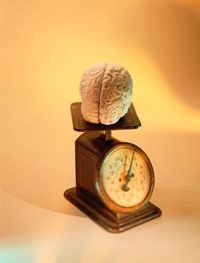Researchers have linked sudden and disproportionate brain growth during the first year of life to autism, suggesting that excessively rapid growth prevents the child from making the connections that guide normal behavior [source: BBC]. Another study indicated that children and adolescents with attention deficit hyperactivity disorder (ADHD) possess brains that are 3 to 4 percent smaller on average than those without ADHD [source: Goode]. Scientists have also revealed that brains shrink with age, though cognitive functions may remain unaltered [source: Britt].
But the question everyone wants to know is, what link exists between a big brain and a big IQ? Is bigger better? Since we're talking about the brain, then surely an enhanced version must lead to more smarts and more talent, right?
Well, it depends which scientist you ask. Scientists have been divided about what they're measuring and how they're measuring it. Anthropologists have long used a skull's interior volume and compared it against body size for a rough estimate of intelligence, measurements known as encephalization quotients. As brain-imaging techniques have improved, though, scientists have measured actual brains with greater precision. But is it size or is it neurons that we need to measure? Is it weight or circumference? Should encephalization quotients use total body weight or lean body mass? Should we correct for body size at all? How do you measure intelligence?
With so many brains tackling these questions, it's hard to reach a consensus on what might be the most meaningful measure. That hasn't stopped researchers from drawing conclusions, though. In 2005, psychologist Michael McDaniel evaluated studies that used brain-imaging and standard intelligence tests and found that unequivocally, bigger brains correlated with smarter people [source: McDaniel].
Since males have the bigger brains, they must have the smarts, right? In one study, scientists converted the SAT scores of 100,000 17- and 18-year-olds to a corresponding IQ score and found that males averaged 3.63 IQ points higher than the females [source: Jackson, Rushton]. The study, did, however, use about 10,000 more females than males, which may have affected the average, but the study's authors believe that the greater the brain tissue, the greater the ability for cognitive processing [source: Bryner].
Remember those studies with twins on the last page? In one study, after the scientists drew conclusions about the role of genetics in brain matter, they gave the twins intelligence tests. They found a link between intelligence and the amount of gray matter in the frontal lobes. Since frontal lobes appeared to be controlled by genetics, the results indicate that parents pass along the potential for genius.
But should gals just throw up their arms, curse their parents and refuse to make sense of nuclear physics? Nope. You've got to go out and shake what your momma gave you. These areas may just lay the groundwork for intelligence down the line or indicate the potential for genius if a person works hard. Albert Einstein may be a perfect example that it may not be overall size that matters, but size of certain sections beyond just the frontal lobe. Einstein, for example, had a perfectly normal-size brain, but certain parts of it were larger than normal, including the inferior parietal region, which affects mathematical thought [source: Wanjek].
It's also worth noting that the strangest things seem to increase brain size. Scientists have found that the brains of London's cab drivers enlarge and change as they learn complicated routes. Cab drivers who have been navigating the streets for years had significant structural changes, as they exhibited a larger posterior hippocampus and a slightly smaller front hippocampus [source: BBC].
So until we know more about all the exact mechanisms of brain growth, you may as well check out the stories on the next page. They just may make you brainier.


